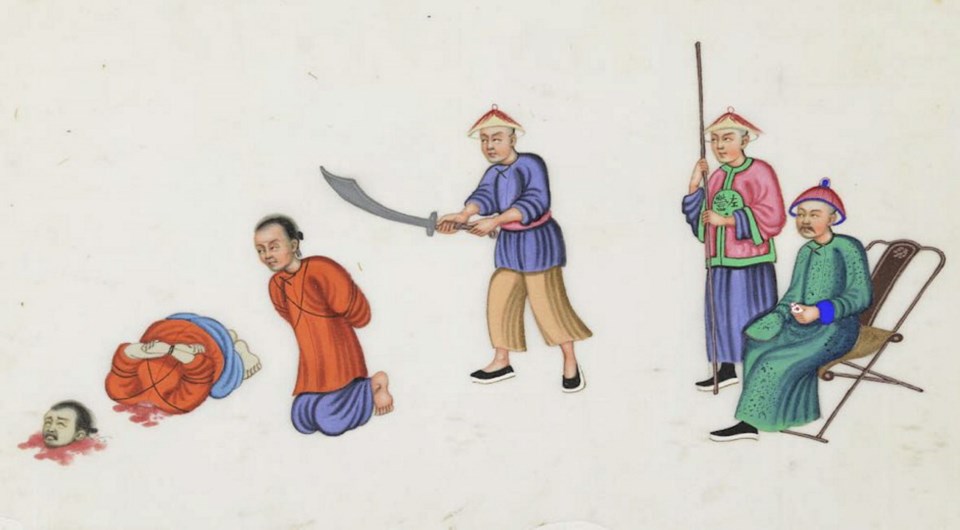Visualizing a Culture for Strangers: Chinese Export Paintings of the 19th Century
Where: Art Gallery of Greater Victoria
When: Opens today, to Jan. 4
Certain 19th-century gentlemen enjoyed a ghoulish pastime — collecting Chinese paintings portraying punishment and executions.
It was the sort of thing one might share with male friends after dinner over brandy and cigars. Mid-19th-century examples of such artworks are included in a new exhibition of Chinese export paintings.
The exhibition, opening today at the Art Gallery of Greater Victoria, is called Visualizing a Culture for Strangers: Chinese Export Paintings of the 19th Century. One painting shows a beheading in which the executioner, having lopped off an unfortunate’s head with a sabre, is poised to chop off another. Other scenes include death by “a thousand cuts,” slapping a criminal’s face for telling lies and lashing a prisoner’s buttocks with a bamboo stick.
“Foreigners loved to have [paintings of] executions, tortures, punishments. The Chinese didn’t like this at all. But they made these albums. The foreigners loved this, though. They thought it showed the exoticness of the country,” said curator Barry Till.
The punishment-execution series (watercolour on pith paper) was a late addition to the exhibition. Till purchased them for the gallery just a month ago on eBay, the online auction. Normally a set of 10 would go for $1,500 — these were advertised for $200. Till put in a reserve bid of $800 and scooped up the entire set for a bargain $450.
Despite being a last-minute addition, the punishment-execution paintings were included in a 128-page hard-cover exhibition catalogue. The series is a small part of the gallery’s 100-painting exhibition of Chinese export paintings, the largest such collection in Canada.
Because the artists were trying to cater to Western tastes, Chinese export paintings show the influence of European art. Chinese artists began using such Western techniques as one-point perspective (using a single vanishing point on a horizon) and chiaroscuro ( the use of light and shading to create the illusion of three dimensionality).
The most valuable piece in Visualizing a Culture for Strangers is a large painting, The Bund, Shanghai, donated to the gallery in 1996. A highly detailed artwork showing a waterfront district in Shanghai with foreign trading ships in the foreground, it is worth about $200,000. Perhaps the most unusual work is an 1820s painting of a Chinese-Jewish businessman, titled A Native of the Province of Ho-nan (A Jew). Till believes it’s the earliest surviving painting of a Chinese Jew.
The subject matter is vast. Some paintings show Chinese playing traditional games, including cricket and quail fighting. Others depict different types of dress, cityscapes, opium smoking, weddings, funerals, porcelain and furniture manufacture.
Most of the collection was recently donated by the Vancouver-based descendants of Sir James Brabazon Urmston (1785-1850) who was president of the East India Company in China. The main benefactor, Hugh Hamilton, told Till he wanted the donated artworks to be put to “good use.”
The Asian art curator assured Hamilton this would be the case. “I said: ‘If I get these, I’ll publish them [in a catalogue ] really quickly,’” Till said with a smile.
